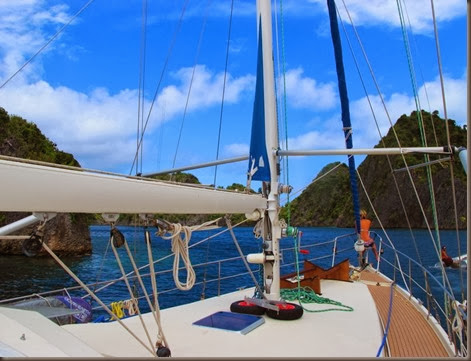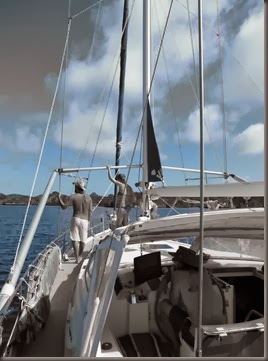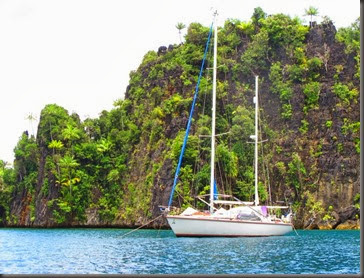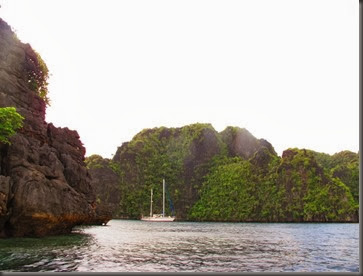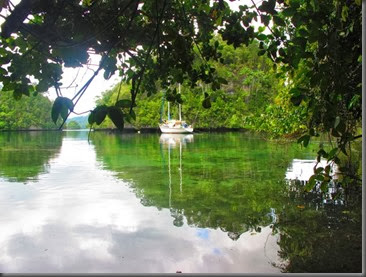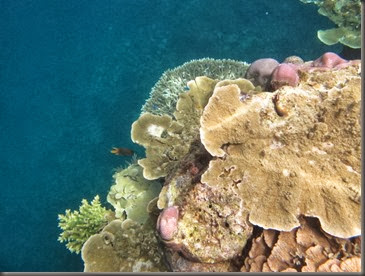It seems like a lifetime ago when Delos was in the cool, calm waters of the Pacific Northwest. I remember sitting on the deck layered in my Patagonia thermals and wearing my smart wool socks with sandals. Sometimes when it was really chilly I’d cover up with one of those blankets with armholes. I really wanted to swim. I couldn’t though- the water was 55 degrees (about 12C) and I would have a case of hypothermia in no time.
I’d gaze up at the sheer cliffs, massive trees, and clear blue skies and wonder if it would be possible for anchorages to have babies. What if you could mate Princess Louisa Inlet in Desolation Sound with Tahiti? Would it be possible to have super awesome views, sheer cliffs, and millpond calm anchorages, then throw in a sandy beach, replace the pine trees with swaying palms, and make it all warm enough you wouldn’t dare dream of wearing socks? Of course, you’d also want to sprinkle in the best parts of the Great Barrier Reef while you’re at it.
Welcome to Raja Ampat, Indonesia! Here just a few miles south of the equator the stunning blue water is dotted with limestone islands that form part of the largest archipelago in the world. What looks like a solid land mass on the chart is in reality a maze of protected inlets and waterways that run for miles and miles. Secret spots are literally around every corner and with a good eye for the shallows you can really find some special spots here.
Anchoring in Raja Ampat is a little trickier than some places, much more than just dropping the hook in the shallows and backing down. First off it’s very, very deep right up until it’s very, very shallow. It’s typical for the depth to go from 250ft to 10 feet within a boat length. A trait obviously from the Desolation Sound side of the family- where it’s normal to let out all 300 feet of your chain then slowly back towards a cliff face until it hooks on something deep down below before tying your stern off to a tree..
Most of the anchorages we’ve found in Raja Ampat are deeper than they are wide. There’s just no way to carry enough chain to anchor properly, and even if you did the slightest breeze or current would swing you into a boat smashing limestone wall. So we use the same tactic learned so many years before. Drop the anchor in deep water and stern tie to pretty much anything we can get our hands on. In a few real cozy places we gave up on the anchor all together and tied both the bow and stern, creating a spider web of lines to hold us in place.
Being a stones throw from the equator means it’s warm, a trait obviously from the Tahitian side of the family. Actually, the water is warm but the air is downright hot. With daily temperatures approaching 100F (38C) and water temps hovering near 85F (29C) you find yourself wanting to spend as much time below the surface as above it. Which turns out to be a really good thing because the bio-diversity of fish and coral here is by far the best we’ve seen in nearly 4 years of sailing and diving across the South Pacific. Obviously from that long lost cousin The Great Barrier Reef (in it’s better years). Snorkeling and diving off the boat is really intense, with dozens of coral and fish species occupying every square inch of the reef. Seriously, it’s like swimming in an aquarium. Except it’s massive. And your house is floating in it.
We’ve been in Raja Ampat for about a month now and have seen some amazing sights- both above and below the water. And best of all there isn’t a blanket or sock in sight.
Carefully maneuvering Delos into the back waters of Raja Ampat.
Delos securely tied up amongst the limestone cliffs. All this appears as one solid mass on the charts.
Awesome diving and snorkeling right off the stern!


